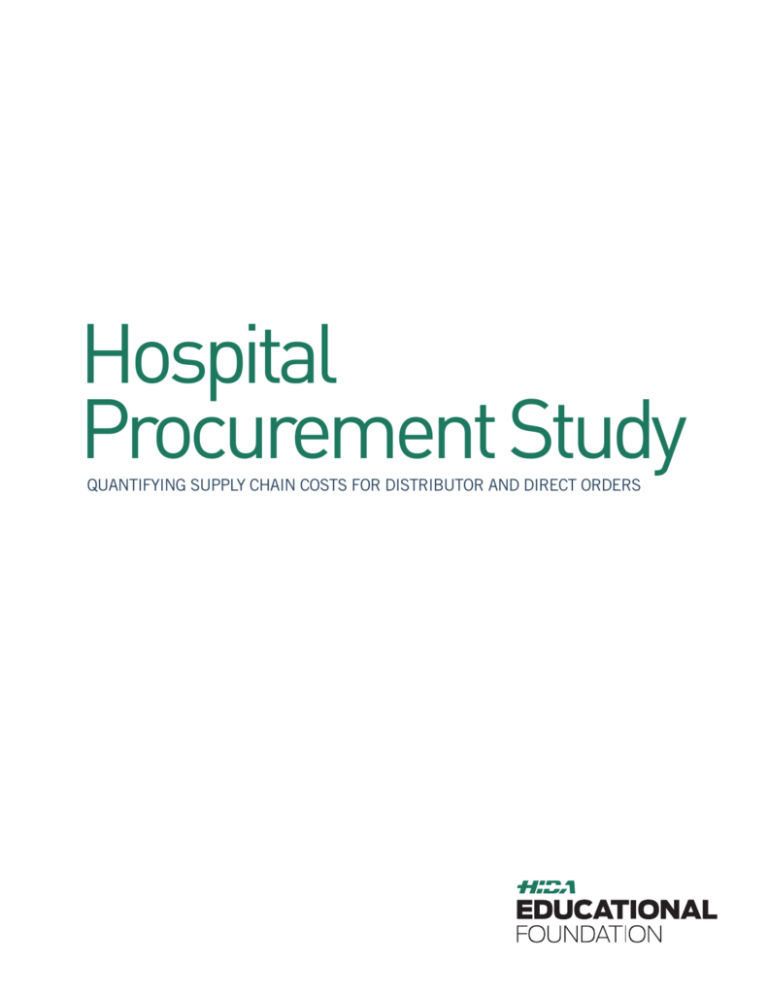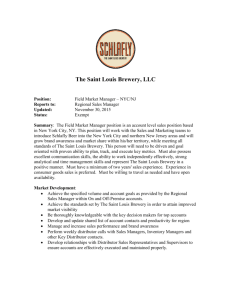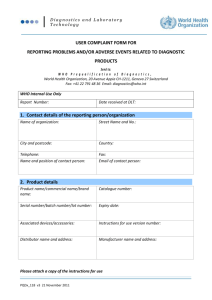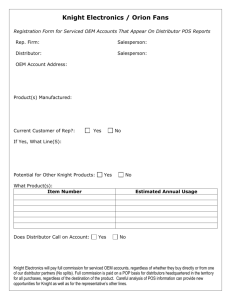
Hospital
Procurement Study
QUANTIFYING SUPPLY CHAIN COSTS FOR DISTRIBUTOR AND DIRECT ORDERS
The Hospital Procurement Study was conducted by PricewaterhouseCoopers (PwC) for the Health Industry Distributors Association.
Copyright 2012 PwC. All rights reserved. The contents of this publication may not be reproduced by any means, in whole or in part, without prior
written consent of the publisher.
For more information about HIDA membership, products, or services, please contact HIDA at 703-549-4432.
Health Industry Distributors Association (HIDA)
310 Montgomery Street
Alexandria, Virginia 22314-1516
Phone: 703-549-4432 • Fax: 703-549-6495 • www.HIDA.org
Printed May 2012
Executive Summary
Facing rapidly increasing financial pressures, hospitals continue to seek more costand time-saving methods to acquire supplies. One area of increasing interest is the
hospital or healthcare system’s supply chain model, in particular, whether greater
efficiencies are possible by maximizing the share of spending through a commercial
distributor, or by increasing the share of purchases directly from manufacturers.
This study compared the activities and related costs associated with these two categories of purchasing. The results point to greater efficiencies through distributor purchases, particularly in the areas
of product ordering and receiving. While some high-dollar products do not fit well with the most
common cost models for commercial distribution, increasing the share of commodity products purchased through a prime vendor distributor makes sense for most facilities, and many could benefit
from investigating a low-unit-of-measure model that transfers additional activities to the distributor.
Highlights from the study include:
• Hospitals use EDI – a time and cost saver – more prevalently with distributor orders than
manufacturer direct orders.
• Hospitals working with distributors more frequently use automation to create purchase orders,
another time saver.
• Hospital receiving time is reduced when using distributors.
• “Just-in-time” programs streamline inventory management functions often resulting in savings
that eclipse the cost of implementing such programs.
Study Overview
This study compared hospitals’ internal process costs for goods purchased directly from a manufacturer
to those associated with purchases using a distributor. All participating hospitals utilized a commercial distributor in some way. For the purpose of the study, costs are those related to supply chain staff
activities for purchasing and receiving functions, not the monetary value (price) of items purchased.
The study was conducted in two parts:
1. An in-depth analysis and interview process of eight hospitals.
2. A procurement/receiving survey completed by an additional 24 hospitals.
In some cases additional market information was utilized to suppliment the study. However, observations and conclusions in this report are based strictly on study results.
For purposes of this study, “med-surg” items are defined as commodity products used throughout a
hospital and repetitively ordered, such as bandages, syringes, etc. Physician preference items (PPI)
are products specific to a clinical service line (urology, neurology, etc.) typically with a higher unit cost.
Hospital Procurement Study
3
Key Themes
Throughout study interviews and subsequent data analysis, two key themes were consistently
demonstrated:
1. The level of automation utilized is a key factor in process cost and efficiency.
2. The complexity of processes, including number of touch points and number of activities/steps, is
another key factor. Simpler processes increase efficiency.
These themes played out in each of the major study findings.
Key Findings
Finding 1. Internal process costs for procurement/ordering are lower with a distributor.
Based on survey data, internal process costs are lower when purchasing from a distributor, as
opposed to purchasing direct from the manufacturer. This is due in large part to the streamlined
purchasing process provided by distributors. The processes used to purchase from distributors are
more efficient than those of manufacturers due in large part to data and technology integration.
On average, the cost to place an order with a distributor is $.44 per line as compared to $1.47 with
a manufacturer (see Figure 1). The higher manufacturer order cost can be attributed to several
“touch points” a direct-to-manufacturer purchase order must pass. These touch points involve
manual processes such as requisitioning, adding information to the purchase order, or a review
and sign-off process.
Figure 1 – Cost to Create PO Line
$1.47
$0.44
Distributor
4
Manufacturer-direct
Quantifying Supply Chain Costs for Distributor and Direct Orders
Figure 2 – Time to Create PO Line
3.3 min
27 sec
Distributor
Manufacturer-direct
Survey respondents reported spending an average of 1.3 minutes per line to generate a purchase
order. A closer look reveals that placing distributor orders took hospitals 27 seconds per PO line
while manufacturer-direct orders required 3.3 minutes per PO line (Figure 2). Annually, reporting
hospitals submitted over 1.2M total or an average of 53k PO lines for manufacturer-direct orders
– the majority related to PPI and roughly 2.6M total or an average of 114k PO lines for distributor
orders. In other words, 77 percent of PO line creation time is spent on manufacturer-direct orders
versus 23 percent for distributors yet the total number of PO lines does not drastically differ (Figure 3).
Figure 3 – Percentage of Time Spent on PO Line Creation
23%
n Distributor
n Manufacturer-direct
77%
Hospital Procurement Study
5
Figure 4 – Average Percentage of Spend by Channel
15%
n Distributor
n Manufacturer-direct
85%
As hospitals look at their distribution models, many reference the “spend” for specific products in
the distribution channel. However, relying too heavily on this data point can prove misleading and
hospitals should not evaluate their distribution channel usage without analyzing additional factors.
The “spend” for manufacturer-direct items clearly outweighs related “spend” for med-surg items
(Figure 4), but this is due to the fact that PPI plays a major role in direct purchases and is therefore
where the majority of direct-manufacturer purchase dollars are spent.
With that in mind, one PPI factor to consider is that the associated cost is prohibitive to a “cost
plus” model, where distributors add a percentage of the product cost as their fee for service. For
higher-priced products (such as implants, valves, etc.), the “cost plus” scenario would produce a
high dollar amount that is disproportionate to the actual cost of distributing that specific product. To
better adjust the distribution cost to fit PPI products, some distributors are utilizing a fee for service
model whereby a “shelf fee” or “activity fee” approach allows many physician preference products
to be handled by the distributor in a cost-effective way. This approach has potential for both hospitals and distributors, and capitalizes on the significant ordering cost advantage versus utilizing the
direct model. However, implications related to product damage liabilities, inventory carrying costs,
and a commitment regarding utilization from the hospitals must be simultaneously considered.
6
Quantifying Supply Chain Costs for Distributor and Direct Orders
Figure 5 – Percentage of Orders Submitted via EDI
96%
33%
Distributor
Manufacturer-direct
Contributing factors:
Distributor orders are three times more likely to be electronic. Varying levels of electronic data
interchange (EDI) are being used in the hospitals surveyed. The majority of electronic orders are
placed with a distributor. Hospitals use EDI for 96% of distributor orders compared to just 33% for
manufacturer-direct orders (Figure 5). Manufacturer-direct orders cannot be placed electronically
unless interfaces exist between the manufacturer and hospital. This indicates that hospitals may
require more assistance and financial support to expand their information technology footprint and
maximize EDI functionality.
Across the hospitals surveyed, only 33 percent of manufacturer-direct orders were sent via EDI with
some organizations reporting significantly higher rates. Over the past decade, distributors have made
great strides, significantly engaging organizations in using this ordering method.
Use of automation to create purchase orders vastly increases efficiency. By and large, distributors
provide high velocity commodity items such as dressings, needles, syringes, catheters, and routine
sterile products used in procedures. The majority of these items are used across multiple clinical
areas and are maintained via periodic automated replenishment (PAR) levels. Eighty percent of
surveyed organizations use automated distribution units (ADU) to manage their PAR locations. These
systems are typically interfaced to their materials management information system (MMIS) and
automatically generate purchase orders for routine stock items. ADUs represent the most efficient
method currently available for managing healthcare inventory orders. Hospitals with advanced supply chain practices typically allow routine non-stock orders to release without requiring any manual
intervention. The sheer volume of PO lines resultant from these practices significantly reduces the
average per line cost to process orders to distributors.
Hospital Procurement Study
7
Figure 6 – Cost to Create PO Line
$0.44
n Distributor
n Manufacturer-direct
$1.47
Consistent purchases of products from an item master or formulary reduces staff time and cost.
Products sold through a distributor are more likely to be items that are already incorporated into the
healthcare organization’s MMIS system with established product records linked to established vendor and contract pricing. This streamlines the requisitioning process and in turn expedites the procurement for these items. It is commonly found that buyers routinely use manual techniques in the
requisition process when dealing with manufacturers. In fact, some buyers use hardcopy catalogs or
search catalogs online to complete a requisition. This practice is a contributing factor in purchasing
time per PO line and gives distributor orders additional efficiencies which translate into 1/3 of the
per line cost compared to a direct order with a manufacturer (Figure 6).
8
Quantifying Supply Chain Costs for Distributor and Direct Orders
Figure 7 – Cost to Receive PO Line
$0.22
$0.15
Distributor
Manufacturer-direct
Finding 2. Internal receiving costs are lower with a distributor.
According to study results, processing costs were lower when receiving items from a distributor as
opposed to receiving items direct from the manufacturer. On average, the cost to receive a line from
a distributor is $0.15 versus $0.22 to receive a line on a manufacturer-direct order (see Figure 7).
The average daily value ($ per FTE hour) of time spent on receiving distributor orders is $67 as
opposed to $131 spent on manufacturer-direct orders (Figure 8). This equates to more than 50
percent efficiency savings in processing costs when receiving orders from a distribution channel.
Figure 8 – Average Daily Value of Time Spent on Receiving PO Lines
$131
$67
Distributor
Hospital Procurement Study
Manufacturer-direct
9
Figure 9 – Cost to Receive PO Line
$0.15
$0.03
Distributor
Manufacturer-direct
Contributing Factors:
Distributor use of advance ship notice reduces receiving time. The advanced ship notice (ASN)
creates efficiencies in receiving and staging products for use within an organization. Many distributors have resources and functionality to provide hospitals with the “856” notification EDI transaction. This notification transmits information from the vendor captured during the order picking cycle.
The data provided can be used by most MMIS to automatically populate the receiving document
based on actual picked quantities thereby reducing the time and effort required to enter receipts
into the system. This results in a dramatic reduction of receiving and invoice matching problems.
Just-in-time programs streamline receiving functions. The advent of just-in-time (JIT) or lowunit-of-measure (LUM) programs by major distributors have allowed hospitals to order and receive
product in the appropriate unit of measure for direct transfer from loading dock to point of use.
Distributors charge hospitals for JIT or LUM services by line charge method or by overall volume
cost. JIT and LUM rely on the use of electronic and automated systems already integrated within the
hospital such as MMIS, EDI platforms, ADUs, and point of use technology.
10
Quantifying Supply Chain Costs for Distributor and Direct Orders
Across the industry, approximately 50 percent of hospitals rely on these types of programs. JIT and
LUM capabilities have virtually eliminated the need for on-hand inventory of commodity items. As
a result, fewer resources are used for receiving and stocking where JIT and LUM are used. The key
benefit to these programs is the elimination of touch points that traditionally included placement of
products in the “general stores,” picking the product, and subsequent delivery to the using location.
Many hospitals find the added expense of JIT/LUM programs are well worth the benefit of reducing
inventory and product touch points while still maintaining immediate access to needed products.
Further, JIT products arrive on the distributor’s truck and are staged for delivery to the PAR or
inventory location where staff retrieve the product, noting any discrepancy in the physical product
received as they stock. The entire order is then auto-received with discrepancies noted. This practice
demonstrates JIT’s value. Participating hospitals reported that JIT programs actually saved money
with cost per distributor PO line received averaging 10-20 percent of that for hospitals not using a
program (Figure 9).
Transportation costs are higher for direct-buy products. Although not included in the valuations
provided as part of the study, it should be noted that transportation costs for PPI and other products purchased directly from manufacturers are higher than those for products purchased through a
distributor. This difference increases the overall procurement costs. Some of these differences are
unavoidable due to the nature of the products. Clinically important items are often purchased on
a replacement basis or even for a specific scheduled procedure. Due to the demands of the clinical environment, many preference products are shipped overnight or second day air to meet case
requirements thus driving up the total cost due to high freight costs. However, not all direct-buy
products are created equal. Healthcare providers should analyze this spend and the related transportation costs and make sure each type of product is purchased in the manner than minimizes total
transportation costs and maximizes efficiency.
Hospital Procurement Study
11
Recommendations
Applying the lessons and practices from the study’s participating hospitals, there are several actions
hospitals can take to reduce processing costs and leverage the value distributors provide.
Maximize use of distributors for regularly purchased supplies – Hospitals should leverage distributor expertise in managing high volume med-surg formulary. In addition, distributors can provide efficiencies in the ordering process through a substitution list in the event of manufacturer backorders
and stock-outs that is seamless for the hospital.
Manage item master file for manufacturer direct products – Adding all routinely utilized manufacturer direct products to the item master file streamlines the requisitioning and ordering of product.
This also allows hospitals to link products to established contract pricing and capture product
volume, helpful for negotiating contracts, and calculating case expense in clinical service areas for
higher cost commodity items.
Maximize EDI – Hospitals with EDI capabilities should maximize the use of these functions, specifically the advanced ship notifications. Increasing the level of automation in the ordering process will
increase process efficiencies and lower administrative costs.
Consider JIT/LUM – Where feasible, hospitals should consider JIT/LUM programs to manage their
supplies. Often the cost of implementation is negated due to increased efficiencies in the receiving
and stocking process. For organizations that do not use JIT/LUM, increasing the number of items in
the supply inventory may help to reduce processing costs; however, inventory carrying costs must be
considered when determining the overall impact to total cost.
Investigate ways to move PPI through current supply chain model – Hospitals should encourage
distributor and manufacturer collaboration on PPI to identify cost effective methods that achieve
distribution efficiencies. To further collaborate with distributors, innovative contracting (product
liability responsibility) should be considered as well as employing consistent ordering methods in
clinical areas.
Demand innovation and change – As an overall recommendation, hospitals should continue to push
for new and innovative methods to manage their business. Many of the items noted above are practical and should be pursued expeditiously.
12
Quantifying Supply Chain Costs for Distributor and Direct Orders
Conclusion
Costs are imbedded in processes such as creating a requisition, the creation and sending of purchase orders, and receiving activities. These costs can be mitigated through the use of technology
and the streamlining of activities.
Maximizing the use of distributors for commodity items is an economically sound practice. With a
distribution partner, processing costs are lowered without a substantial increase in product cost with
the distribution fee. It is generally cost prohibitive for the higher dollar, physician preference items
to be purchased through distribution channels. However, alternative pricing models may offer a
mechanism to secure the advantages of distribution while limiting controlling costs. These physician preference items are the major difference in product purchased from distributors as opposed to
direct from manufacturers.
The supply chain maturity level of a hospital contributes to the cost differential between distributors and manufacturers particularly with regard to traditional distribution models versus direct order
models. Programs offered by distributors such as low-unit-of-measure and JIT – frequently present
in more mature supply chains – can help hospitals reduce costs and gain efficiencies in repetitive
processes.
Hospital Procurement Study
13
Appendix
Methodology
This study was conducted in two parts.
In part one, a detailed, in-depth data analysis and interview was conducted with eight hospitals
varying in size, location and function. Key financial and operational elements were observed and
recorded for comparison. The collected elements and observations were used to define the operational variations in processes utilized for the procurement and receipt of distributed goods versus
manufacturer direct goods. While recognizing there is a cost associated with each, it was the goal of
this study to determine whether traditional distribution channels or manufacturers with direct order
relationships hold the higher costs for an organization and demographic consistency in these costs.
In part two, a survey was provided via email to over 50 participants. This survey was aimed at a wide
audience and was designed to gather key data elements correlating to the internal cost of procuring
and receiving supplies.
At each of the in-depth hospital studies, facility and supply chain specific data were retrieved. These
data elements are used to compare and contrast the facilities, as it compares supply expense of
distributor and manufacturer-direct delivered items. Interviews with key facility operators within the
supply chain department were conducted to identify anecdotal information related to operational
practices. This information provided further insight to the direct operating costs associated with
obtaining supplies. Information such as time spent on returns and number of miss-shipments per
month allowed the examination of the day to day operational differences for a hospital working with
distributed and manufacturer-direct items. These operational differences are factored into the cost
of doing business with each of the sellers.
The surveys include specific procurement and receiving data that correspond to obtaining supplies
from distributors and direct from manufacturers. This includes the use of different technological
functions, which is a major component of the healthcare industry today. Only Procurement and
Receiving information were analyzed for comparison purposes.
14
Quantifying Supply Chain Costs for Distributor and Direct Orders
Demographics
The gathered data were assimilated and analyzed through a data warehouse built for the purposes
of the study. It consisted of 78 unique data elements gathered from each hospital participant, and
138 interview questions related to functions and operations at each hospital. Hospital specific data
remained confidential and all reporting has been done in aggregate. The survey included 27 unique
data elements that were compared and analyzed in accordance with study parameters.
Bed Size (Averages based on hospital size)
Less than 400
400 or Greater
Patient Days
63,807
97,420
Discharges
14,121
71,522
1.51
1.65
Operating Expense
$289,415,688
$851,635,106
Med-surg Supply Expense
$31,889,868
$110,454,722
Number of OR Cases per Year
11,042
18,609
Number of Cath Lab Procedures per Year
2,898
11,323
762,820
1,587,962
19.75
46
Case Mix Index
Number of Lab Billable Tests
Number of Supply Chain Management FTEs
Bed Size (Averages based on hospital size)
Less than 300
300-500
Greater than 500
Hourly Salary for Purchasing Staff
$35.29
$34.84
$31.06
Buyer Hours per Week Spent on
Distributor Purchasing
22
12.25
40
Buyer Hours per Week Spent on
Manufacturer Purchasing
64.5
35.75
112
Hourly Salary for Receiving Staff
$20.09
$19.50
$19.32
Hours per Day Spent Receiving from
Distributors
2.9
5.4
2.67
Hours per Day Spent Receiving from
Manufacturers
5.2
9.6
8.67
Total Annual Dollars Spent with
Distributors
$4,177,306
$7,079,725
$78,434,860
Total Annual Dollars Spent with
Manufacturers
$24,356,127
$58,233,916
$149,585,205
Number of PO Lines to Distributors
Annually
26,054
32,881
196,391
Number of PO Lines to Manufacturers
Annually
27,802
48,591
128,181
Use of Electronic Requisitioning
100%
100%
100%
Use of ADU System
84%
83%
67%
Hospital Procurement Study
15
310 Montgomery Street • Alexandria, VA 22314-1516
Ph: 703-549-4432 • www.HIDA.org • Fax: 703-549-6495








